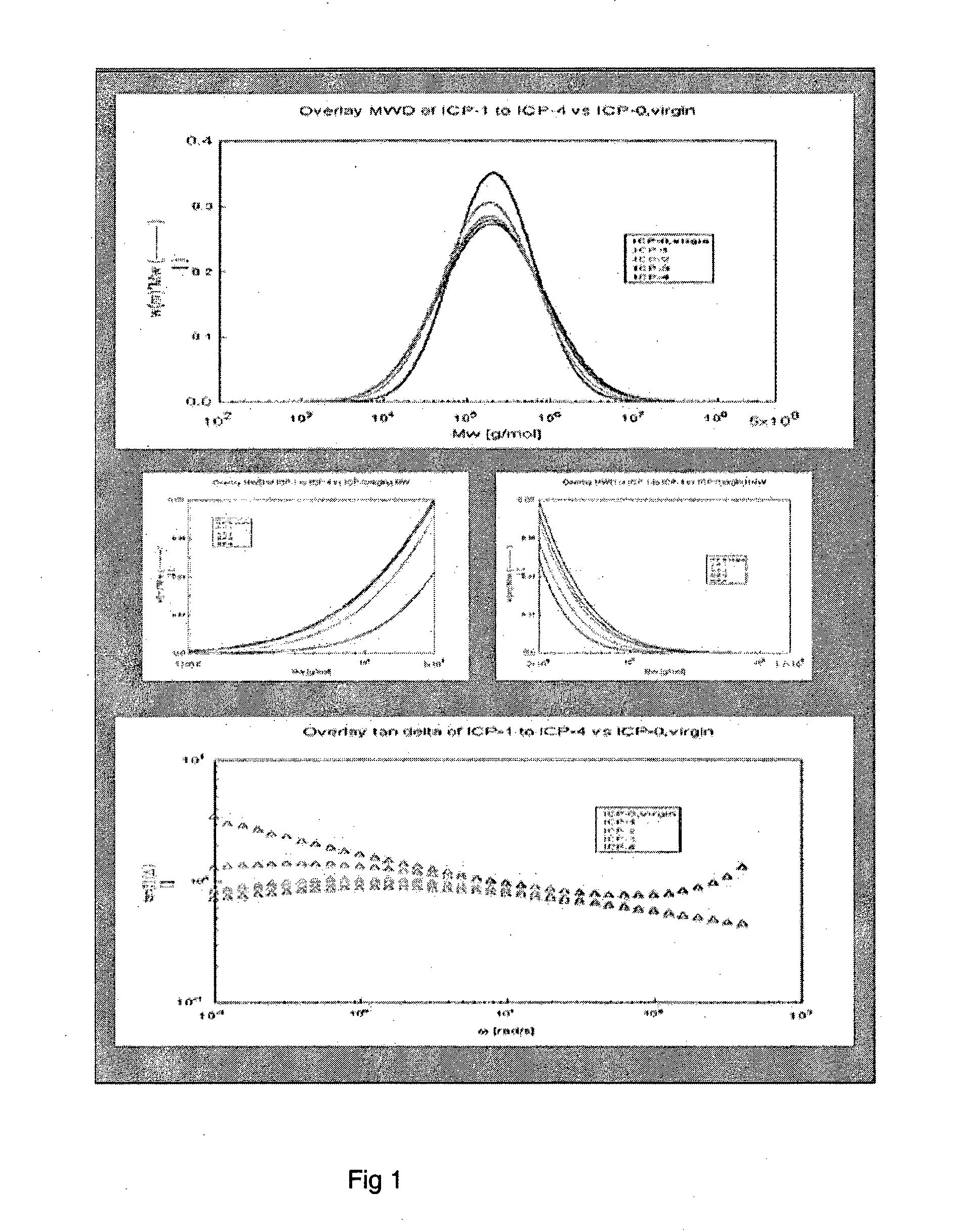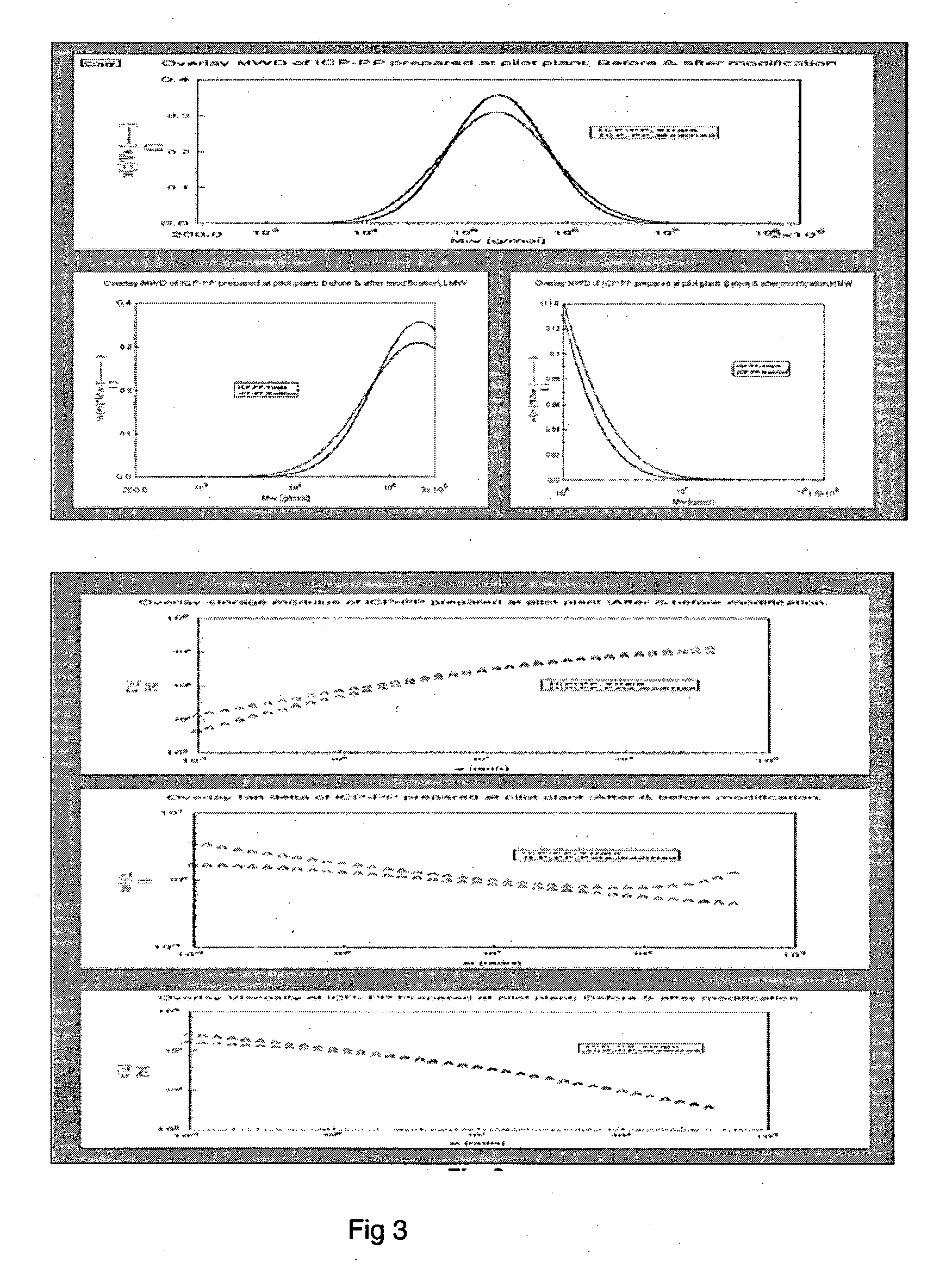Process for preparing high melt strength propylene polymers
- Summary
- Abstract
- Description
- Claims
- Application Information
AI Technical Summary
Benefits of technology
Problems solved by technology
Method used
Image
Examples
example 1
[0090]500 g batch mixture of PP-ICP
[0091]Batch size: 500 g Matrix, PP-ICP & 30 ppm PEROXIDE:
[0092]Pentaerythritol triacrylate (PETA:Modifier) variation
[0093]50% of the Polypropylene was blended with a concentrate of trifunctional monomer (i.e. termed as co-agent / modifier) containing peroxide with thorough mixing. In the subsequent step remaining part of polymer was added & mixed perfectly for uniform dispersion of modifier. Irganox-1010 (i.e. 0.05% w / w based on total matrix used for modification) & Irgafos-168 (i.e. 0.1% w / w based on total matrix) followed by 0.06% calcium stearate were added to the whole mass & blended. Hand mixing operation was repeated several times to ensure proper mixing. The extrusion of PP-ICP containing reactants was carried out on lab model Buss-co-kneader. The temperature in the different zones of the extruder was maintained as Z-1: 1700 C; Z-2: 2300 C; Z-3: 2500 C; & Z-4 (die zone): 2600 C with screw rpm as 90. The extruded material was quenched & palleti...
example-2
[0095](Batch Size: 10 KG; Peroxide: 20 ppm, PETA (when use with peroxide): 0.4% w / w; PETA (without peroxide): 0.5% w / w; Irganox1010: 0.05% w / w; Irgafos-168: 0.1% w / w; calcium stearate: 0.06% w / w;)
[0096]The extrusion of PP-ICP (10 KG batch) was carried out on a twin screw extruder (Co-rotary—screw diameter—25 mm, L / D—25:1 and length 600 mm) using optimized recipe (Temperature profile: 95-250-260-260-260-260-258-263-263° C. & rpm 170) to examine the role of peroxide in reactive modification. It was found that presence of trace level of peroxide had significant impact on melt rheological properties of modified polymer. The process requires 10-20% lesser modifier to achieve desired MFI on modification in as compared to the modified polymer prepared without peroxide. The results are summarized in Table-2 &FIG. 2.
TABLE 2Modification of PP-ICP with & without peroxide on pilot scale:Rheological & Thermal propertiesPETAPeroxideMFITrials(g)(g)g / 10 minG′, Paη, PoisetanδMz + 1MWDTc, ° C.Trial-0...
example-3
[0098]Batch size: 10 Kg of PP-ICP: Pentaerythritol triacrylate (PETA): 40 g; Irganox1010 (Primary antioxidant): 5 g; Irgafos-168 (Secondary AO): 10 g; calcium stearate (Cast): 6 g; Peroxide (Luperox101): 0.2 g)
[0099]10 kg batch was prepared with additives & modifier mixed in a high speed mixer to homogenize the mass before transferring to the feeder at ambient temperature and then extruded on a pilot scale twin screw extruder; the extrusion conditions are given in Table-3. Proper dispersion, mixing temperature, melt temperature & residence time (screw RPM) seem to be important to achieve lower MFI.
TABLE 3ICP-PP reactive extrusion conditionsPP-ICP (1.5 MI)As per recipe forExtruder Parameter(Virgin)modificationMain Drive RPM285170Main Drive Torque %4166-69Temp Z-2 to Z-9 (° C.)210-215-220-230-230-170-200-220-230-240-235-235-240250-260-260Diverter Valve Temp245265Die Plate Temp260260Melt temp before DV254256-261Melt temp after DV206224-225Melt Press before DV141125-129(lim 150)Melt pre...
PUM
| Property | Measurement | Unit |
|---|---|---|
| Fraction | aaaaa | aaaaa |
| Fraction | aaaaa | aaaaa |
| Fraction | aaaaa | aaaaa |
Abstract
Description
Claims
Application Information
 Login to View More
Login to View More - R&D
- Intellectual Property
- Life Sciences
- Materials
- Tech Scout
- Unparalleled Data Quality
- Higher Quality Content
- 60% Fewer Hallucinations
Browse by: Latest US Patents, China's latest patents, Technical Efficacy Thesaurus, Application Domain, Technology Topic, Popular Technical Reports.
© 2025 PatSnap. All rights reserved.Legal|Privacy policy|Modern Slavery Act Transparency Statement|Sitemap|About US| Contact US: help@patsnap.com



